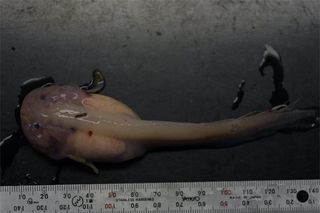Deep-Diving Fish Set Surpising Record

Swarms of fish have been filmed swimming in one of the world's deepest ocean trenches, nearly five miles (nearly eight kilometers) below the surface of the Pacific Ocean.
The fish were caught on film in the Japan trench in the Northwest Pacific. The film also marks the first time that video cameras have been sent this deep in the ocean.
"We got some absolutely amazing footage," said project leader Alan Jamieson of the University of Aberdeen's Oceanlab, on board the Japanese research ship the Hakuho Maru, "more fish than we or anyone in the world would ever have thought possible at these depths."
The video also showed a spunkier fish than expected. "We thought the deepest fishes would be motionless, solitary, fragile individuals eking out an existence in a food-sparse environment," said Monty Priede, director of Oceanlab.
Rather than loners, the fish that the researchers found, called hadal snailfish, were sociable and active, feeding on little shrimp and showing signs of possible family groups in this extreme environment.
Hadal snailfish reside exclusively in deep trenches in the Pacific Ocean, at depths below four miles (nearly seven km). There, they contend with total darkness, near freezing temperatures and water pressures equivalent to 1,600 elephants standing on the roof of a small car.
The fish feed on the thousands of tiny shrimp-like creatures that scavenge the carcasses of dead fish and other debris reaching the ocean floor.
Sign up for the Live Science daily newsletter now
Get the world’s most fascinating discoveries delivered straight to your inbox.
These snailfish are found in trenches off of western South America, in the Kermadec and Tonga trenches between Samoa and New Zealand in the South Pacific, and in trenches of the Northwest Pacific, including the Japan trench, which Priede's team is currently studying.
These deep trenches are created when the heavier oceanic tectonic plate collides with and plunges beneath the lighter continental plates. In these subduction zones, the depth can plummet very steeply to about six miles (nearly 10 km).
The snailfish video and related research are part of Oceanlab's HADEEP project, a collaborative research program with the University of Tokyo devised to investigate life in the ocean's deepest trenches or hadal regions. These are regions that are at least 3.7 miles (six km) deep. The current expedition, which was funded by the Natural Environment Research Council and the Nippon Foundation in Japan, started on Sept. 24 and ended on Monday.
In a separate discovery announced this week, scientists found 274 species of fish, corals, crustaceans and other creatures in very deep waters off the coast of Australia. The newly identified species were found in water more than a mile deep in regions rife with underground volcanoes and dramatic canyons.
- Watch the Deepwater Fish
- Image Gallery: Freaky Fish
- Can Fish Hear?
Most Popular


